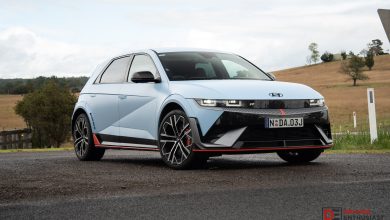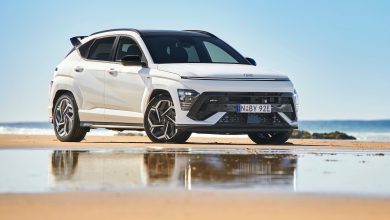Hyundai has announced its all-new Inster, a sub-compact EV designed to redefine the urban mobility segment with a blend of refinement, innovative features, and an impressive range of convenience.
Available in two battery configurations and packed with advanced driver assistance tech, and a versatile interior layout, the Inster is an evolution of the Hyundai Casper – a petrol model that has been available in Korea only. This is going international and will make its way to Australia in the first quarter of 2025.
2025 Hyundai Inster: Specifications
Battery: 42kWh or 49kWh
Output: 71.1kW or 84.5kW, 147Nm
Gearbox: Single-speed auto
Drive type: Front-wheel drive
Wheels: 15in (optional 17in)
Tare weight: 1300-1400kgOfficial consumption: 14.9kWh/100km
Official range: 327km or 370km
Max charging (AC/DC): 11kW/85kW
0-100km/h (claimed): 11.7s or 10.6s
0-100km/h (Vbox tested, 49kWh): 10.38s
Starting price: Around $40,000

2025 Hyundai Inster: How much does it cost?
Two versions will be available, including one with a 42kWh battery and a 49kWh battery. These provide a range of 327km and 370km, respectively. Power outputs are 71.1kW and 84.5kW, respectively, and both generate 147Nm from the front-mounted electric motor.
Prices are expected to start from around AU$40,000 for the entry model. That is a decent entry price for an EV, but considering this is quite a small package, some buyers might find more value in larger and perhaps more powerful options from the emerging Chinese brands.

2025 Hyundai Inster: Interior & packaging
The body measures just 3825mm in length and 1610mm in width, standing 1575mm tall, which means it is easily small enough for manoeuvrability in the city and in tight car parks. With an extended 2580mm wheelbase compared with the old petrol Casper, Hyundai has cleverly balanced the compact dimensions with interior space optimisation, resulting in a surprisingly spacious and comfortable cabin.
Inside, the cabin centres around a modern digital interface, with a 10.25-inch touch-screen taking care of infotainment, offering navigation, phone mirroring, and media controls, while another screen is used for the instrument cluster, providing clear and somewhat customisable driving information.

These screens run the familiar Hyundai software, with easy menu flow and excellent depth of adjustment and settings if you want them. But, fortunately, the climate control is housed on a separate panel with lots of physical buttons as well. Perfect.
For those who value personalisation, Hyundai provides options for two-tone interior themes in hues like Newtro Beige or Khaki Brown, full cloth, while pixel-themed graphics on the steering wheel add a unique touch of modernity. Additionally, Hyundai has used sustainable materials in the interior, including recycled PET and bio-polypropylene sourced from sugarcane.
Practicality also extends to seating and boot space, with front-row walk-through access and the ability to fold the seats flat – including the driver’s seat – for flexible cargo arrangements. The rear seats offer a 50/50 split and can slide and recline individually to adapt to passenger or cargo needs. Maximum boot space with the second row up but all the way forward is 351L, or 280L with them in the rear-most position.

2025 Hyundai Inster: Powertrain & handling
During this test we got to experience the Inster in its natural habitat; the city. Well, specifically, the megacity that is Seoul, in Korea. Here the little Inster is in its element and seemed perfectly fitting, zipping around the tighter streets like a goat up a rocky hill.
We only drove the 49kWh version with its 84.5kW output. Top-end speed isn’t grin-inducing, as you’d expect, but it certainly goes well for what it is. Roll-on acceleration is more its forte, squirting from 40-80km/h with haste and a level of joy. We managed to run two 0-100km/h tests with the Vbox, and it recorded the sprint in 10.83 seconds with the air-con on, and 10.38 seconds with it off.

There are four driving modes to choose from to help increase versatility, including Eco, Normal, Sport, and Snow. Each of these manage throttle sensitivity accordingly, with the Sport mode providing snappier response and low-end pick up. In Eco mode, however, it’s not an absolute slow-coach. It actually feels quite normal, if you’re driving under normal demands.
Drivers can also toggle through six different settings for the brake regen, including an i-Pedal mode which is basically one-pedal driving with maximum braking pressure, as well as a free coasting mode. The most interesting is the Auto mode, which uses the on-board radar sensors to read traffic in front and applies regen braking when needed, but then coasts for efficiency when there is no reason to slow down.

Hyundai has paid particular attention to the Inster’s ride quality and handling, employing hydro bushings in the electric motor mounts to reduce vibration and improve ride comfort. This feature, commonly found in higher-end vehicles, provides enhanced insulation against road disturbances, ensuring a smoother ride over various surfaces.
Combined with a reinforced body structure, the Inster delivers a composed driving experience with minimal harshness and cabin noise for a vehicle of this size. For example, to tackle noise, vibration, and harshness (NVH), Hyundai has taken extensive measures, including applying thicker front door glass, double door seals, and more sound-dampening materials throughout the body.

High-frequency noise is controlled with a motor sound absorption package and optimised airflow around key exterior elements. As a result, the cabin remains remarkably quiet even at highway speeds; a quality not commonly associated with vehicles in this segment. And in particular, petrol vehicles in this segment which usually rev quite high at 100km/h or above.
Hyundai Australia has confirmed it has been testing the new model on local soil, and will apply a unique suspension tune based on the Euro spec for Australia. Engineers were able to hand-select from a range of spring and damper combinations to create a package best suited to our commonly rough conditions.

2025 Hyundai Inster: First impressions
This is a very interesting little package. Not only does it look cool (and it will be available in a range of fresh colours), it is genuinely practical and fun to drive. A clever seating layout with a huge scope for adjustment means the cabin is totally fine for carrying four adults. But yet there is no sacrifice in features or technology, with two big screens, wireless phone charging, and plenty of storage.
Its main challenge will be the price. For such a small car, one might expect a price tag of around $30,000, not $40,000. However, for an electric vehicle, which are still, for some reason, a lot more expensive than their petrol counterparts, the price compares adequately.


























